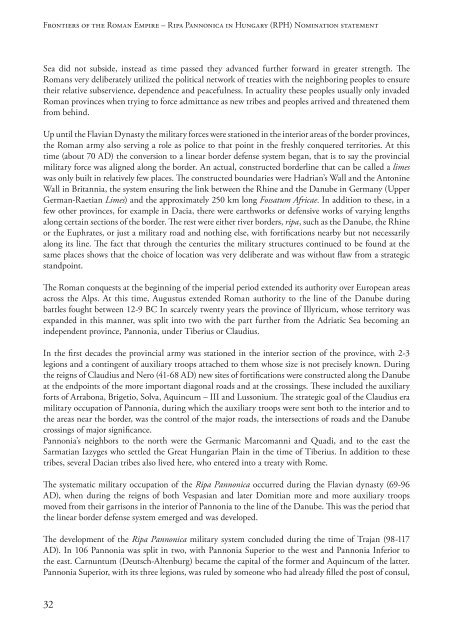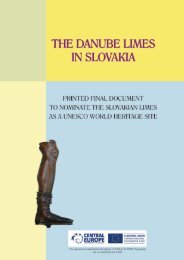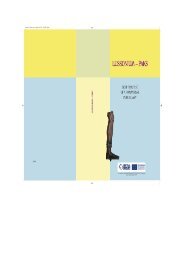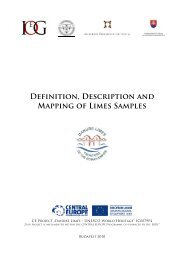the PDF version! - Danube Limes
the PDF version! - Danube Limes
the PDF version! - Danube Limes
You also want an ePaper? Increase the reach of your titles
YUMPU automatically turns print PDFs into web optimized ePapers that Google loves.
Frontiers of <strong>the</strong> Roman Empire – Ripa Pannonica in Hungary (RPH) Nomination statement<br />
Sea did not subside, instead as time passed <strong>the</strong>y advanced fur<strong>the</strong>r forward in greater strength. The<br />
Romans very deliberately utilized <strong>the</strong> political network of treaties with <strong>the</strong> neighboring peoples to ensure<br />
<strong>the</strong>ir relative subservience, dependence and peacefulness. In actuality <strong>the</strong>se peoples usually only invaded<br />
Roman provinces when trying to force admittance as new tribes and peoples arrived and threatened <strong>the</strong>m<br />
from behind.<br />
Up until <strong>the</strong> Flavian Dynasty <strong>the</strong> military forces were stationed in <strong>the</strong> interior areas of <strong>the</strong> border provinces,<br />
<strong>the</strong> Roman army also serving a role as police to that point in <strong>the</strong> freshly conquered territories. At this<br />
time (about 70 AD) <strong>the</strong> con<strong>version</strong> to a linear border defense system began, that is to say <strong>the</strong> provincial<br />
military force was aligned along <strong>the</strong> border. An actual, constructed borderline that can be called a limes<br />
was only built in relatively few places. The constructed boundaries were Hadrian’s Wall and <strong>the</strong> Antonine<br />
Wall in Britannia, <strong>the</strong> system ensuring <strong>the</strong> link between <strong>the</strong> Rhine and <strong>the</strong> <strong>Danube</strong> in Germany (Upper<br />
German-Raetian <strong>Limes</strong>) and <strong>the</strong> approximately 250 km long Fossatum Africae. In addition to <strong>the</strong>se, in a<br />
few o<strong>the</strong>r provinces, for example in Dacia, <strong>the</strong>re were earthworks or defensive works of varying lengths<br />
along certain sections of <strong>the</strong> border. The rest were ei<strong>the</strong>r river borders, ripa, such as <strong>the</strong> <strong>Danube</strong>, <strong>the</strong> Rhine<br />
or <strong>the</strong> Euphrates, or just a military road and nothing else, with fortifications nearby but not necessarily<br />
along its line. The fact that through <strong>the</strong> centuries <strong>the</strong> military structures continued to be found at <strong>the</strong><br />
same places shows that <strong>the</strong> choice of location was very deliberate and was without flaw from a strategic<br />
standpoint.<br />
The Roman conquests at <strong>the</strong> beginning of <strong>the</strong> imperial period extended its authority over European areas<br />
across <strong>the</strong> Alps. At this time, Augustus extended Roman authority to <strong>the</strong> line of <strong>the</strong> <strong>Danube</strong> during<br />
battles fought between 12-9 BC In scarcely twenty years <strong>the</strong> province of Illyricum, whose territory was<br />
expanded in this manner, was split into two with <strong>the</strong> part fur<strong>the</strong>r from <strong>the</strong> Adriatic Sea becoming an<br />
independent province, Pannonia, under Tiberius or Claudius.<br />
In <strong>the</strong> first decades <strong>the</strong> provincial army was stationed in <strong>the</strong> interior section of <strong>the</strong> province, with 2-3<br />
legions and a contingent of auxiliary troops attached to <strong>the</strong>m whose size is not precisely known. During<br />
<strong>the</strong> reigns of Claudius and Nero (41-68 AD) new sites of fortifications were constructed along <strong>the</strong> <strong>Danube</strong><br />
at <strong>the</strong> endpoints of <strong>the</strong> more important diagonal roads and at <strong>the</strong> crossings. These included <strong>the</strong> auxiliary<br />
forts of Arrabona, Brigetio, Solva, Aquincum – III and Lussonium. The strategic goal of <strong>the</strong> Claudius era<br />
military occupation of Pannonia, during which <strong>the</strong> auxiliary troops were sent both to <strong>the</strong> interior and to<br />
<strong>the</strong> areas near <strong>the</strong> border, was <strong>the</strong> control of <strong>the</strong> major roads, <strong>the</strong> intersections of roads and <strong>the</strong> <strong>Danube</strong><br />
crossings of major significance.<br />
Pannonia’s neighbors to <strong>the</strong> north were <strong>the</strong> Germanic Marcomanni and Quadi, and to <strong>the</strong> east <strong>the</strong><br />
Sarmatian Iazyges who settled <strong>the</strong> Great Hungarian Plain in <strong>the</strong> time of Tiberius. In addition to <strong>the</strong>se<br />
tribes, several Dacian tribes also lived here, who entered into a treaty with Rome.<br />
The systematic military occupation of <strong>the</strong> Ripa Pannonica occurred during <strong>the</strong> Flavian dynasty (69-96<br />
AD), when during <strong>the</strong> reigns of both Vespasian and later Domitian more and more auxiliary troops<br />
moved from <strong>the</strong>ir garrisons in <strong>the</strong> interior of Pannonia to <strong>the</strong> line of <strong>the</strong> <strong>Danube</strong>. This was <strong>the</strong> period that<br />
<strong>the</strong> linear border defense system emerged and was developed.<br />
The development of <strong>the</strong> Ripa Pannonica military system concluded during <strong>the</strong> time of Trajan (98-117<br />
AD). In 106 Pannonia was split in two, with Pannonia Superior to <strong>the</strong> west and Pannonia Inferior to<br />
<strong>the</strong> east. Carnuntum (Deutsch-Altenburg) became <strong>the</strong> capital of <strong>the</strong> former and Aquincum of <strong>the</strong> latter.<br />
Pannonia Superior, with its three legions, was ruled by someone who had already filled <strong>the</strong> post of consul,<br />
32











